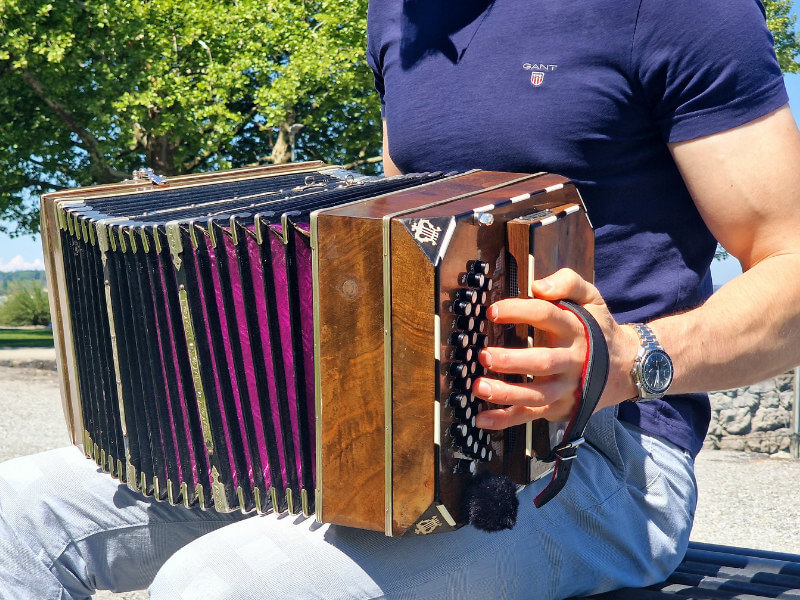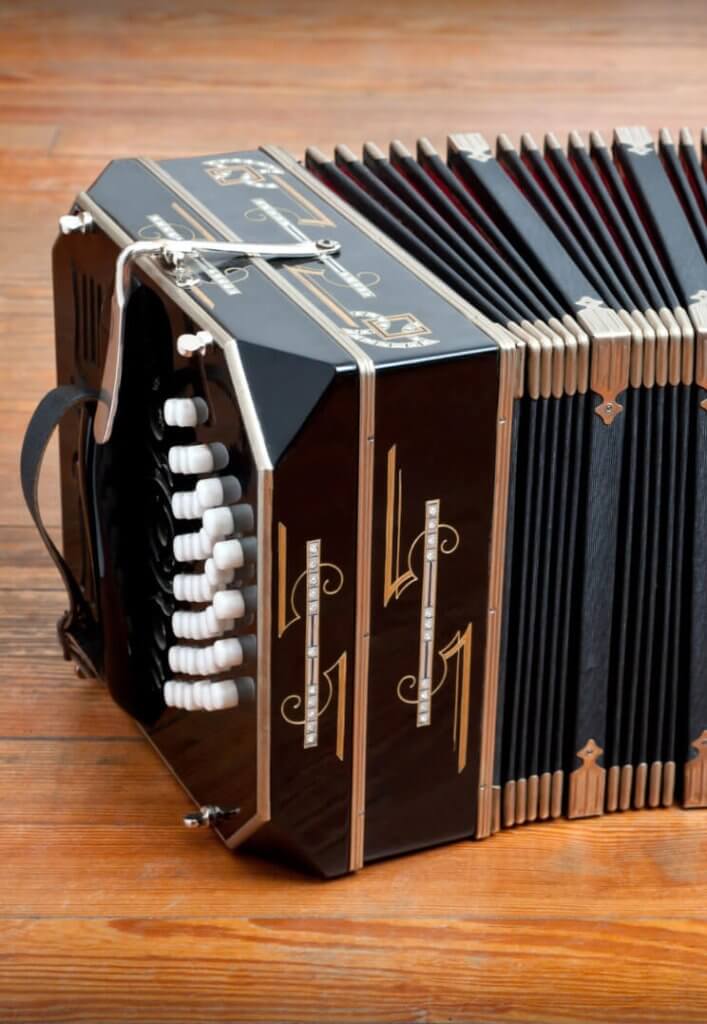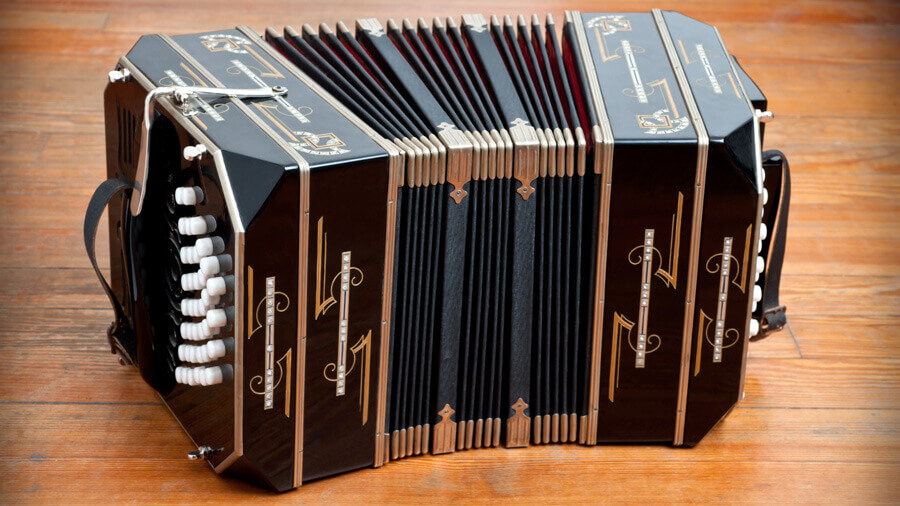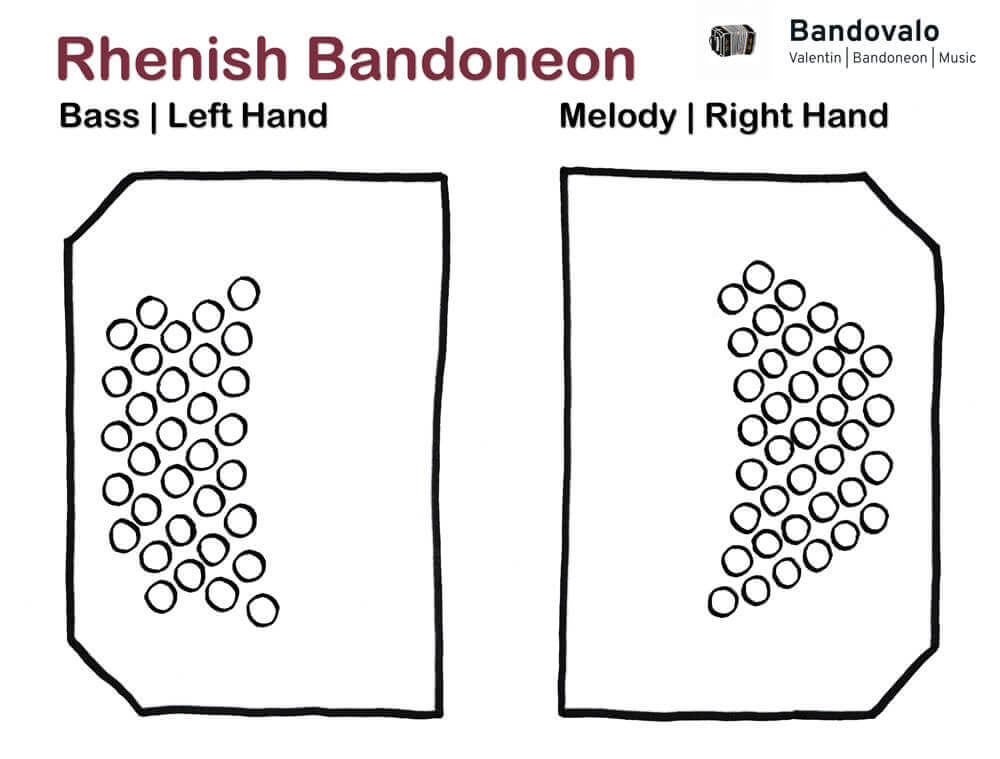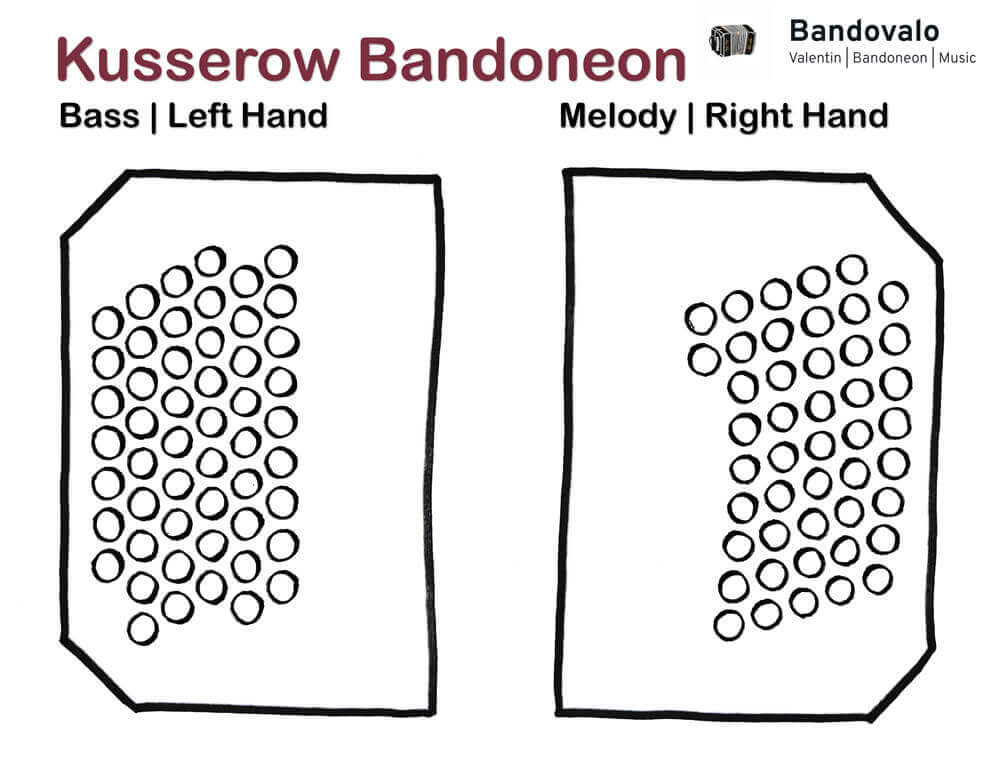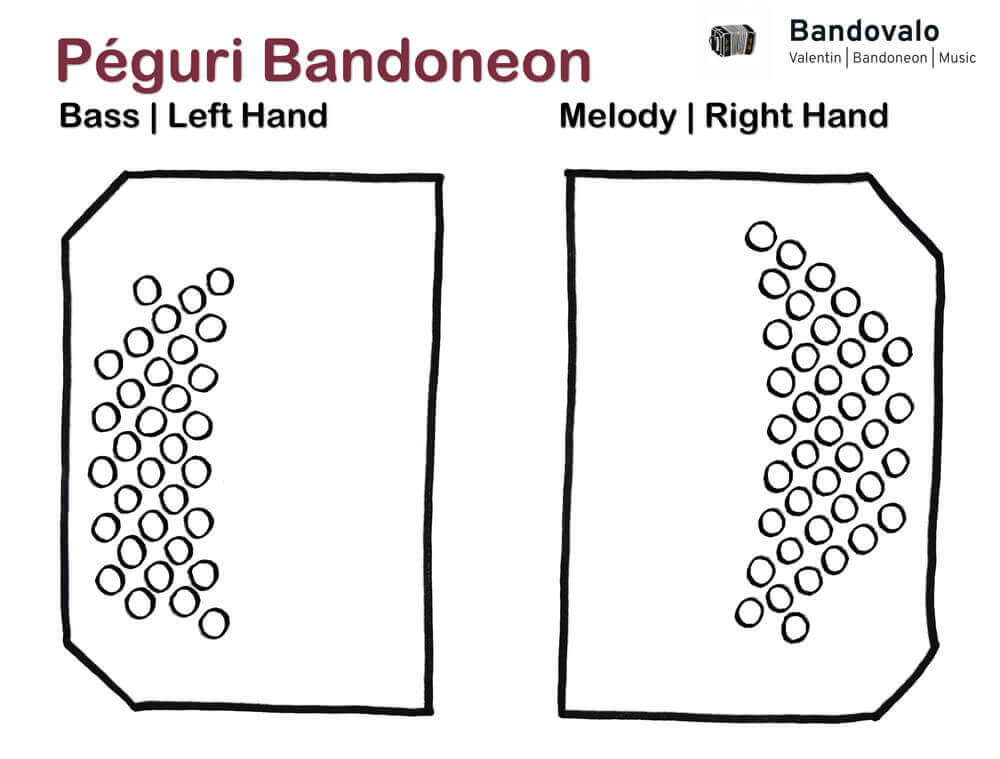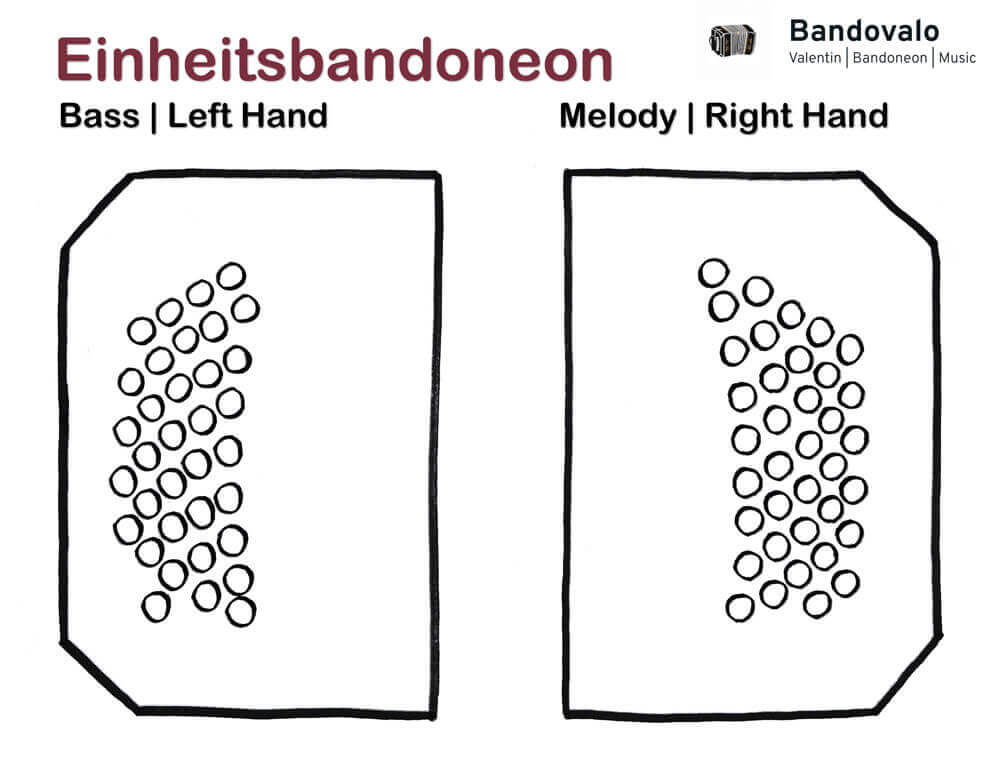Bandoneon Structure – Components & Systems
In this guide, I explain the bandoneon structure in clear, practical terms.
You’ll learn what a free-reed instrument is (airflow makes metal reeds vibrate), how bellows control shapes dynamics, how the Rhenish layout organizes notes,
and what unisonoric systems change compared with the bisonoric standard.
What Is a Bandoneon?
The bandoneon is a bisonoric free-reed aerophone, which means that each button sounds two different notes:
One when I push the bellows and another when I pull.
It belongs to the concertina-type instrument family, where airflow makes metal reeds vibrate to create sound. The instrument is built from two square wooden boxes with rows of buttons, joined by flexible bellows.
If you want to understand the button layout of the bandoneon, just jump to the button layout section in this article.
Bandoneon Structure: Main Components
- Wooden sound boxes: These form the body of the bandoneon. They hold the buttons, valves, and reed plates, giving the instrument both stability and resonance.
- Folding bellows: Made of fabric, leather, and cardboard, the bellows act like the lungs of the instrument. They generate air pressure and allow precise bellows control, which shapes phrasing and dynamics.
- Free reeds: Thin tongues of steel or brass that vibrate when air flows across them. Some bandoneons use octave-tuned reeds to add warmth and volume.
- Reed plates (bandoneon): These secure the reeds inside the instrument. In the bandoneon structure, reed plates are key to tonal stability and tuning accuracy.
- Buttons and valves: By pressing a button, I open a valve that directs air to a chosen reed. This mechanism completes the bandoneon build and gives direct control over pitch.
If you want to hear how the instrument sounds in practice, take a look at my bandoneon videos here on the website of Bandovalo.
How It Works & Playing Technique
The bandoneon structure works by channeling air through metal reeds.
When I expand or contract the bellows, I create air pressure — the driving force of the instrument.
Pressing a button opens a small valve that directs air to a specific reed, making it vibrate and produce sound. This is what defines the bandoneon as a free-reed instrumenti Wind instrument with flexible metal reeds.
Each button produces two tones — one on the push and one on the pull.
These “push/pull notes” make the bisonoric bandoneon more complex than most other concertina-type instruments, but they also give it a wide expressive range.
Technique turns this design into music. The key is bellows control — I use the bellows like a singer uses breath, shaping dynamics, accents, and phrasing.
The treble side sounds clear and bright, while the bass side is darker and more nasal. This contrast gives the bandoneon its unmistakable voice in tango and classical music.
Bandoneon Keyboard Layouts
Keyboard systems show how the bandoneon structure shapes the way I learn and play. The choice of layout changes ergonomics and finger patterns, but it does not change the sound of the reeds.
In other words, the bandoneon structure mainly affects orientation, not timbre.
Within the bandoneon structure, the most common system is the Rheinische bandoneon (Rhenish layout). It has 38 buttons on the right hand and 33 on the left, giving 71 buttons and 142 tones.
To play fluently, I must master four separate maps: right push, right pull, left push, and left pull. This makes the learning curve steep, but it also explains why the Rhenish layout became the standard in tango.
Unisonoric Chromatic Bandoneons
Variants such as the Kusserow system and the Péguri bandoneon system produce the same tone on push and pull.
This unisonoric design makes scales and chords more logical, so beginners can learn faster and improvise more freely.
However, these systems are rare in tango traditions.
They change the ergonomics of playing but keep the underlying bandoneon construction of reeds and bellows intact.
For the detailed diagrams download my PDFs:![]() PDF Kusserow Bandoneon Layout
PDF Kusserow Bandoneon Layout![]() PDF Péguri Bandoneon Layout
PDF Péguri Bandoneon Layout
Bisonoric Einheitsbandoneon
The Einheitsbandoneon (144-tone) was created to unify different layouts and offer a standard system for teaching. It is a bisonoric bandoneon, meaning each button plays two different notes (push and pull).
In practice, tango players have preferred the 142-tone Rheinische system, which remains the reference for most repertoire.
The contrast between 142 and 144 tones highlights how much the bandoneon structure influences tradition as well as pedagogy.
For a standardized 144-tone system, download my PDF:![]() PDF Einheitsbandoneon Layout
PDF Einheitsbandoneon Layout
Choosing Between Bisonoric and Unisonoric
The bisonoric bandoneon is the traditional choice in tango. Each button plays two notes (push and pull), which gives a wide expressive range and authentic phrasing.
The downside: it is harder to learn, because I must memorize four different note maps.
The unisonoric chromatic bandoneon plays the same note on push and pull.
This makes scales and improvisation more logical, so beginners can progress faster.
However, it changes ergonomics and limits access to some of the tango repertoire built for the bisonoric layout.
I personally play a bisonoric bandoneon — the Einheitsbandoneon, just like the one shown in the picture above.
If you’d like to hear how it sounds in practice, feel free to visit my YouTube channel where I share performances and playing examples.
Common Misconceptions
- “The unisonoric sounds different.”
False — the timbre is nearly identical. The difference lies in ergonomics, not in sound production. - “The real tango bandoneon must be bisonoric.”
This is a cultural tradition, not a technical rule. Tango developed on bisonoric systems, but unisonoric instruments can play the same repertoire. - “Diatonic vs. chromatic.”
Both layouts can play full chromatic scales. The terms are historical and do not limit the instrument’s range.
Do you know other myths about the bandoneon? Add them in the comments and join the discussion.
Micro-FAQ
Yes. It belongs to the family of free-reed aerophones, like accordions and harmoniums. Its reeds vibrate when air flows across them, which defines the instrument’s sound.
On a bisonoric bandoneon, each button plays two tones — one when I push the bellows and another when I pull.
This push/pull principle is central to the bandoneon structure and explains why beginners find the layout challenging.
The Rhenish layout (Rheinische bandoneon) is the most common system with 142 tones.
It organizes notes into four maps (right/left, push/pull) and shows how the bandoneon structure arranges scales and chords.
Here you will find the button layout of the Rhenish bandoneon layout.
Conclusion
The bandoneon structure brings together wooden boxes, folding bellows, and free reeds into one expressive instrument.
Whether I play a bisonoric or a unisonoric system, mastering the bandoneon starts with understanding its construction and the logic of its keyboard layouts.
This knowledge makes practice more efficient and performance more confident.
The latest Blogs
Tango Instruments: Typical Instrumentation and Roles
November 4, 2025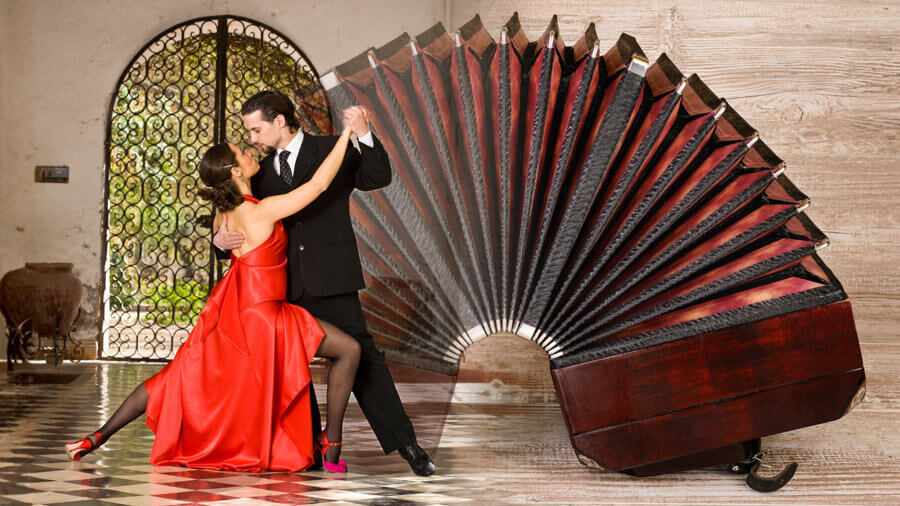
Bandoneon Origin — From German Invention to the Soul of Tango
September 24, 2025
